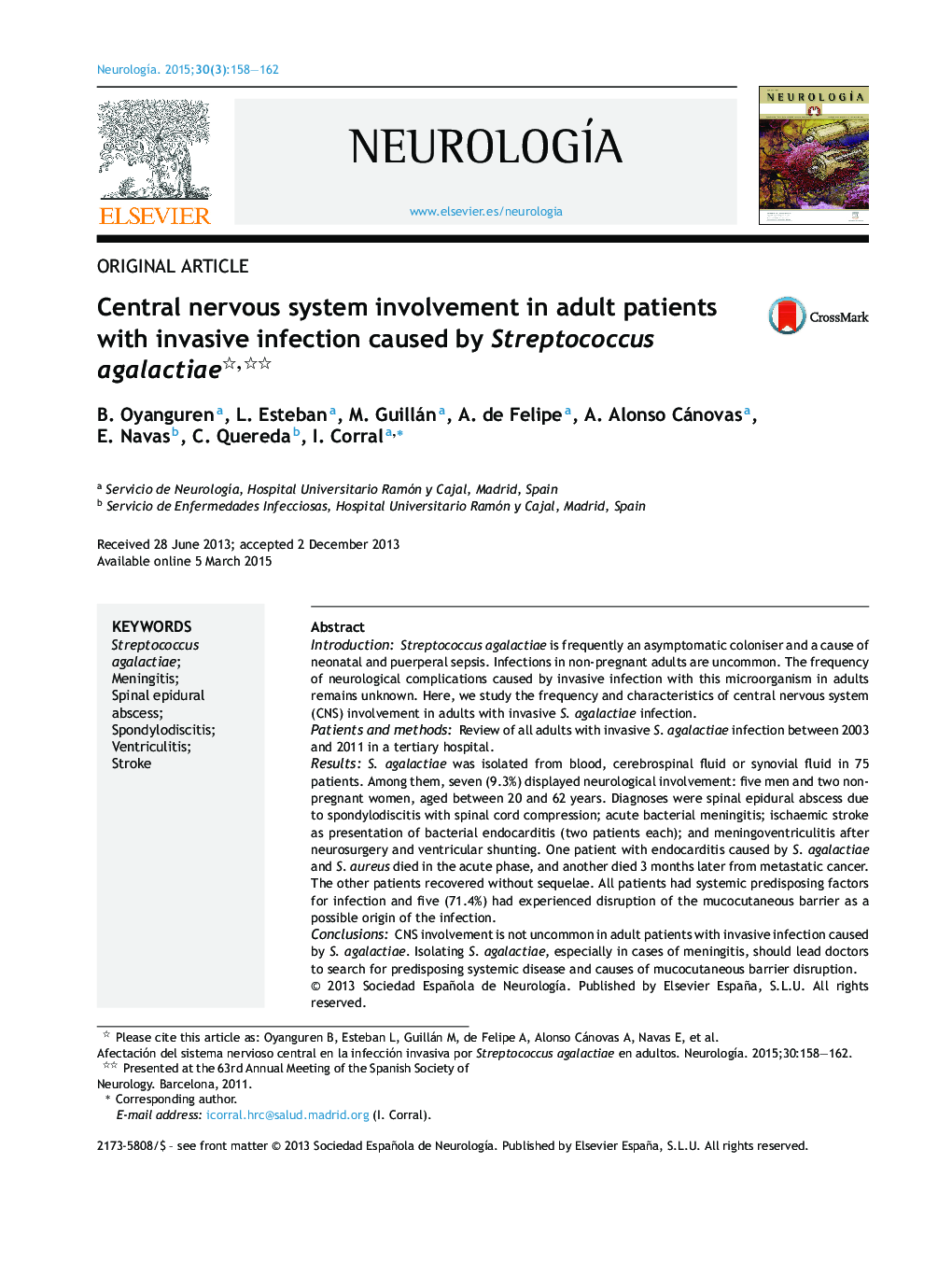| کد مقاله | کد نشریه | سال انتشار | مقاله انگلیسی | نسخه تمام متن |
|---|---|---|---|---|
| 3077303 | 1189134 | 2015 | 5 صفحه PDF | دانلود رایگان |
IntroductionStreptococcus agalactiae is frequently an asymptomatic coloniser and a cause of neonatal and puerperal sepsis. Infections in non-pregnant adults are uncommon. The frequency of neurological complications caused by invasive infection with this microorganism in adults remains unknown. Here, we study the frequency and characteristics of central nervous system (CNS) involvement in adults with invasive S. agalactiae infection.Patients and methodsReview of all adults with invasive S. agalactiae infection between 2003 and 2011 in a tertiary hospital.ResultsS. agalactiae was isolated from blood, cerebrospinal fluid or synovial fluid in 75 patients. Among them, seven (9.3%) displayed neurological involvement: five men and two non-pregnant women, aged between 20 and 62 years. Diagnoses were spinal epidural abscess due to spondylodiscitis with spinal cord compression; acute bacterial meningitis; ischaemic stroke as presentation of bacterial endocarditis (two patients each); and meningoventriculitis after neurosurgery and ventricular shunting. One patient with endocarditis caused by S. agalactiae and S. aureus died in the acute phase, and another died 3 months later from metastatic cancer. The other patients recovered without sequelae. All patients had systemic predisposing factors for infection and five (71.4%) had experienced disruption of the mucocutaneous barrier as a possible origin of the infection.ConclusionsCNS involvement is not uncommon in adult patients with invasive infection caused by S. agalactiae. Isolating S. agalactiae, especially in cases of meningitis, should lead doctors to search for predisposing systemic disease and causes of mucocutaneous barrier disruption.
ResumenIntroducciónEl Streptococcus agalactiae (S. agalactiae) es un germen frecuentemente colonizador asintomático y causante de sepsis neonatal y puerperal. Las infecciones en adultos, fuera del embarazo, son poco frecuentes. No se conoce la frecuencia de complicaciones neurológicas en adultos con infección invasiva por este microorganismo. Hemos estudiado la frecuencia y las características de la afectación del sistema nervioso central (SNC) en pacientes adultos con infección invasiva por S. agalactiae.Pacientes y métodosSe revisó a todos los pacientes adultos con infección invasiva por S. agalactiae en un hospital terciario entre 2003 y 2011.ResultadosEn 75 pacientes se aisló S. agalactiae en sangre, líquido cefalorraquídeo o líquido articular. De ellos, 7 (9,3%) tuvieron afectación neurológica: 5 hombres y 2 mujeres no embarazadas, con edades entre 20 y 62 años. Los diagnósticos fueron: absceso epidural secundario a espondilodiscitis con compresión medular, meningitis bacteriana aguda, ictus isquémico como presentación de endocarditis bacteriana (2 pacientes cada uno) y meningoventriculitis tras neurocirugía y derivación ventricular. Un paciente con endocarditis por S. agalactiae y S. aureus falleció en la fase aguda y otra a los 3 meses por neoplasia metastásica. El resto se recuperó sin secuelas. En todos los casos, hubo factores predisponentes sistémicos para la infección y 5 (71,4%) tenían rotura de barrera mucocutánea como posible origen de la infección.ConclusionesLa afectación del SNC es relativamente frecuente en pacientes adultos con infección invasiva por S. agalactiae. El aislamiento de S. agalactiae debe hacer investigar causas predisponentes sistémicas y causas de rotura de barrera mucocutánea, sobre todo en meningitis.
Journal: Neurología (English Edition) - Volume 30, Issue 3, April 2015, Pages 158–162
